Morphology control and tunable color of LuVO4:Ln3+ (Ln = Tm, Er, Sm, Eu) nano/micro-structures†
Abstract
LuVO4:Eu3+ nano/microcrystals with different morphologies/sizes including nanoparticles, nanosheets, nanodisks, nanoquadrangles, sub-microflakes, microspheres, and bulks were successfully synthesized by a mild solvothermal process using tartaric acid (TA) as the template. The amount of tartaric acid (TA) and the initial pH value play vital roles in controlling the morphologies of LuVO4 products. Besides, the reaction temperature was responsible for the generation of pure LuVO4 crystals in the presence of TA. Based on this, the possible formation mechanism of multi-morphologies was proposed. Furthermore, the dependence of luminescence performance on morphology has been discussed in detail. The LuVO4:Ln3+ (Ln = Tm3+, Er3+, Sm3+, Eu3+) nanoparticles show the characterized transition of Ln3+ and give bright blue, green, orange-red and red emission. Moreover, blue-green, green-yellow, pink, yellow-pink and white light can be obtained by adjusting the amount of doped Ln3+ ions and the corresponding concentrations of the LuVO4 host. This general and simple method may be of much significance in the synthesis of many other rare earth inorganic materials.



 Please wait while we load your content...
Please wait while we load your content...